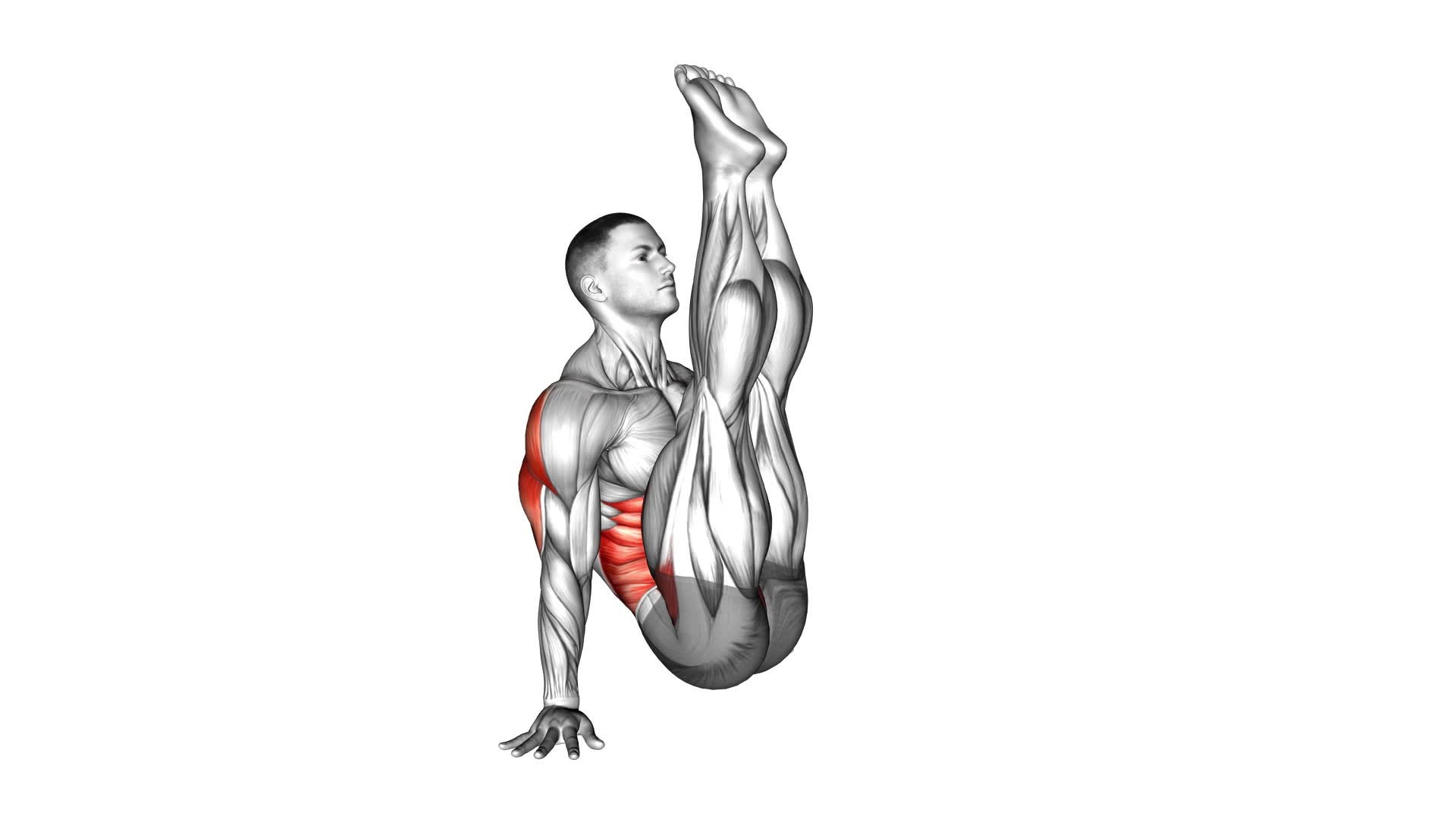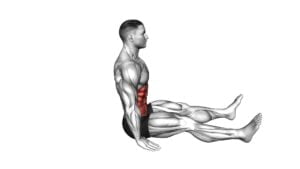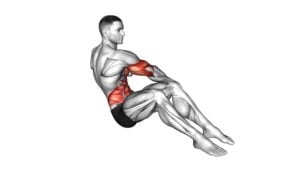V Sit on Floor – Video Exercise Guide & Tips

Are you looking for an effective exercise to strengthen your core? Look no further than the V sit on the floor!
Watch This Exercise Video
This exercise targets your abs, lower back, and hip flexors.
In this video exercise guide, we'll show you the proper form and technique for the V sit on the floor, as well as common mistakes to avoid.
Plus, we'll provide modifications and variations to suit your fitness level.
Get ready to take your core strength to the next level!
Key Takeaways
- The V Sit on Floor targets abs, lower back, and hip flexors.
- It builds core strength and improves flexibility.
- Proper form and technique are important to prevent common mistakes.
- Modifications and variations can be made to increase or decrease intensity.
Benefits of the V Sit on Floor
To maximize the effectiveness of your V Sit on Floor exercise, it's important to understand the numerous benefits that it offers.
The V Sit on Floor is a great exercise for building core strength and improving flexibility. By engaging your abdominal muscles, lower back, and hip flexors, this exercise helps to strengthen the muscles of your core, which are essential for maintaining proper posture and stability. Additionally, the V Sit on Floor can help improve flexibility in your hamstrings, hip flexors, and lower back.
When you perform the V Sit on Floor regularly, you can expect to see an increase in your overall core strength. Strong core muscles not only enhance your athletic performance but also support your spine and help prevent injuries. Moreover, by regularly stretching the muscles involved in the V Sit on Floor, you can improve your flexibility, allowing for greater range of motion in your daily activities and other exercises.
Now that you understand the benefits of the V Sit on Floor, let's move on to the next section where we'll discuss the proper form and technique for this exercise.
Proper Form and Technique for the V Sit on Floor
Now let's delve into the proper form and technique for the V Sit on Floor, which will further enhance the benefits discussed earlier.
To ensure you perform the V Sit on Floor correctly, start by sitting on the floor with your legs extended in front of you. Activate your core muscles by engaging your abs and lifting your chest. Then, begin to lift your legs off the floor while maintaining a straight back and keeping your knees as straight as possible. As you progress with the V Sit on Floor, you can challenge yourself by reaching forward towards your toes or even attempting to lift your hands off the ground.
To improve your flexibility and make the V Sit on Floor easier, incorporate stretches that target the hamstrings, hip flexors, and lower back into your routine. Some of the best stretches for the V Sit on Floor include seated forward bends, seated straddle stretches, and standing hamstring stretches.
Remember to focus on maintaining proper form and technique throughout the exercise to prevent injury and maximize the benefits.
In the next section, we'll discuss common mistakes to avoid during the V Sit on Floor, so you can perform this exercise effectively and safely.
Common Mistakes to Avoid During the V Sit on Floor
You should always be mindful of common mistakes to avoid when performing the V Sit on Floor exercise. Proper form is crucial to ensuring that you get the most out of this exercise and avoid any potential injuries. Here are some common mistakes to watch out for:
- Rounded back: Keep your spine straight and avoid rounding your back during the V Sit on Floor. This will help engage your core muscles effectively and prevent strain on your lower back.
- Lifting your feet too high: When lifting your feet off the floor, make sure you don't go too high. Aim to bring your legs to a 45-degree angle with the floor, maintaining a V shape with your body.
- Holding your breath: Remember to breathe throughout the exercise. Holding your breath can lead to tension and reduce the effectiveness of the V Sit on Floor.
- Lack of core engagement: Ensure that you're engaging your core muscles throughout the movement. This will help you maintain stability and control during the exercise.
Modifications and Variations of the V Sit on Floor
When performing the V Sit on Floor exercise, there are various modifications and variations that can be incorporated to add variety and challenge to your workout routine. If you find the V Sit on Floor too difficult, you can start with alternative core exercises such as seated knee tucks or seated Russian twists. These exercises target the same muscles as the V Sit on Floor but with less intensity.
To progress and make the V Sit on Floor more challenging, you can try different variations. One option is to add weight by holding a dumbbell or medicine ball in your hands while performing the exercise. This will increase the resistance and engage your core muscles even more. Another variation is to extend your legs straight out in front of you instead of keeping them bent. This requires more strength and balance, making the exercise more advanced.
Additionally, you can incorporate progressions for the V Sit on Floor to further challenge yourself. One progression is to perform the exercise on an unstable surface, such as a stability ball or Bosu ball. This requires more core stabilization and strength. Another progression is to add a twisting motion at the top of the V Sit, alternating sides to work your obliques.
Tips for Incorporating the V Sit on Floor Into Your Fitness Routine
To incorporate the V Sit on Floor into your fitness routine, consider these tips for maximizing the effectiveness of the exercise:
- Start with proper alignment: Sit on the floor with your legs extended in front of you and your spine tall. Engage your core and lift your chest.
- Breathe deeply: Focus on deep inhales and exhales as you hold the V Sit position. This will help you stay centered and connected to your body.
- Incorporate V Sit into your yoga practice: The V Sit is a great addition to any yoga routine. Use it as a transition between poses or as a way to strengthen your core during balancing poses.
- Progress to advanced variations: Once you feel comfortable with the basic V Sit, challenge yourself with progressions. Try lifting your legs off the ground, extending your arms overhead, or adding a twist to engage different muscles.
Incorporating the V Sit on Floor into your fitness routine can bring a new level of core strength and stability. Whether you're new to yoga or an advanced practitioner, these tips will help you make the most of this exercise. Remember to listen to your body and modify as needed.
Frequently Asked Questions
How Long Should I Hold the V Sit on Floor Position?
To get the most out of the V sit on the floor, you should hold the position for as long as you can maintain proper form without straining yourself.
The V sit is a challenging exercise that targets your core muscles and improves your balance. By holding the position, you engage your abs, obliques, and lower back, which helps strengthen your core.
Remember to start with modifications if needed and gradually increase the duration as you build strength and endurance.
Can I Do the V Sit on Floor Exercise if I Have Lower Back Pain?
If you're dealing with lower back pain, it's important to listen to your body and avoid exercises that exacerbate the discomfort. The V sit on the floor can put strain on your lower back, so it may not be the best option for you.
Instead, focus on lower back pain management and try alternative exercises that strengthen your core without causing additional pain. Consult with a healthcare professional or a certified trainer for personalized guidance.
Is It Necessary to Warm up Before Performing the V Sit on Floor?
Before performing the V sit on the floor, it's important for you to warm up. Warming up helps increase blood flow and flexibility, reducing the risk of injury. Additionally, warming up prepares your muscles for the exercise, allowing you to perform it more effectively.
Proper form is also crucial in the V sit on the floor to maximize its benefits. Engaging your core and maintaining a straight back will help you target the abdominal muscles and improve overall stability.
Can I Do the V Sit on Floor Exercise if I Have Limited Flexibility?
If you have limited flexibility, you might be wondering if you can still do the V sit on the floor exercise. The answer is yes! Even with limited flexibility, there are modifications you can make to still benefit from this exercise.
It helps strengthen your core, improve balance, and increase hip flexibility. By gradually working on the V sit and using props like yoga blocks, you can gradually improve your flexibility over time.
How Often Should I Incorporate the V Sit on Floor Into My Fitness Routine for Best Results?
To get the best results from the V Sit on Floor exercise, you need to consider the optimal frequency of incorporating it into your fitness routine.
This exercise can be a great addition to your routine, but it's important to listen to your body and not overdo it. Make sure to include variations and modifications to challenge yourself and avoid plateauing.
Incorporating this exercise 2-3 times a week is a good starting point, and you can adjust as needed based on your progress and goals.
Conclusion
Incorporating the V Sit on Floor into your fitness routine offers numerous benefits, including improved core strength and flexibility.
By maintaining proper form and technique, you can maximize the effectiveness of this exercise. Avoid common mistakes such as rounding your back or straining your neck.
Additionally, consider modifications and variations to challenge yourself and prevent boredom.
Remember to listen to your body and make adjustments as needed.
Start incorporating the V Sit on Floor today for a stronger and more resilient body.

Author
Years ago, the spark of my life’s passion ignited in my mind the moment I stepped into the local gym for the first time. The inaugural bead of perspiration, the initial endeavor, the very first surge of endorphins, and a sense of pride that washed over me post-workout marked the beginning of my deep-seated interest in strength sports, fitness, and sports nutrition. This very curiosity blossomed rapidly into a profound fascination, propelling me to earn a Master’s degree in Physical Education from the Academy of Physical Education in Krakow, followed by a Sports Manager diploma from the Jagiellonian University. My journey of growth led me to gain more specialized qualifications, such as being a certified personal trainer with a focus on sports dietetics, a lifeguard, and an instructor for wellness and corrective gymnastics. Theoretical knowledge paired seamlessly with practical experience, reinforcing my belief that the transformation of individuals under my guidance was also a reflection of my personal growth. This belief holds true even today. Each day, I strive to push the boundaries and explore new realms. These realms gently elevate me to greater heights. The unique combination of passion for my field and the continuous quest for growth fuels my drive to break new ground.



